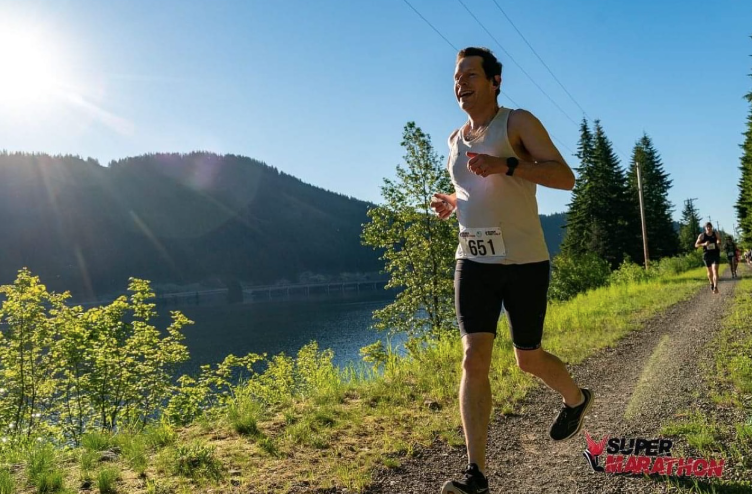Learning how to differentiate between “good” and “bad” pain

As athletes, pain is a companion from time to time. In fact, a substantive portion of our training is designed specifically to help us learn to tolerate discomfort and to work through suffering. If we are going to achieve our big dreams, pain will be a part of that process – both in training and on race day.
There are different types of pain, such as lung-searing pain, muscle-burning pain, or long-run achy pain. There is “good” pain that comes from a quality training session, like the mild soreness you might get from strength training or a new speed workout. This discomfort lets us know we pushed our bodies just outside of the comfort zone in order to create fitness gains. This is known as exertional discomfort.
Then, there is the “bad” pain, which communicates something is wrong, such as a sharp tweak in the knee or a bruised and sprained ankle. This pain isn’t about pushing outside of the comfort zone. This pain is about a possible looming or existing injury. But if we listen to our bodies, we may just be able to head off an issue before it becomes an injury.
While there are some clear-cut cases of “good” and “bad” pain, it is not always easy to distinguish between the two in practice. In this article, I’ll review some of the key signs for each type of pain. An important caveat is that each of our bodies are unique. Some pain may seem normal, but it could be a sign of a bigger issue – and vice versa. When in doubt, always report symptoms to your coach and/or go see a sports medicine professional.
“Normal” Discomfort
Let’s be honest: you will get uncomfortable when you train and race. Endurance sport requires suffering, and our training prepares us to tolerate it. There is no amount of training we can do that will get rid of this discomfort. The best we can do is learn how to tolerate it – especially mentally.
Generally speaking, I consider normal sensations as discomfort, rather than threatening pain. That being said, discomfort is technically a type of pain. In most cases, we can continue to push through this discomfort without harming the body (as long as we allow proper recovery after training or racing).
Some signs of “normal” discomfort include:
- Mild to moderate muscle discomfort during a workout, which usually presents as a dull sensation or ache. This pain is not sharp, nor does it impede or alter mobility or movement.
- Burning muscles or lungs during high intensity, which goes away a few minutes after you stop.
- Mild to moderate soreness that goes away after 48 hours or less. This is delayed onset muscle soreness – DOMS. The severity of DOMS will dictate how hard you can go the next day or two, but it is not necessarily a sign that something is wrong.
- Fatigue that comes toward the end or after a workout. It is normal to feel tired when we finish. Training breaks us down! Rest up and you’ll be ready to get back to it the next day. If the fatigue lingers after recovery, your body may need more rest or active recovery.
“Bad” Pain
If you’ve trained long enough, you’ve experienced one or more types of “bad” pain. This pain warns us that there is an issue brewing or that an injury has already occurred. Admittedly, there is a blurry line between “normal” and “bad”. Always report pain and accidents to your coach. Failing to do so can cause even worse injury. (It will also make your coach upset once they find out.)
Pay attention to any of the following signs, especially if they start to create a pattern with certain movements or for a series of days. In this case, that pain is telling you something.
Location
One way to distinguish normal from bad pain is if the discomfort is location-specific. The more localized the pain, the more likely it is to be the sign of an issue brewing. For example, pain may be:
- Specific to a particular body part (e.g., patella, achilles, front of the shoulder).
- Consistently triggered by a specific movement. For example, if you always feel a sharp pull every time you pull during swimming, that is most likely not okay. There is something amiss in the shoulder that needs treatment.
- In an area where you had a previous injury. For some injuries, previous issues are a precursor to future issues.
Types of sensations
Any of the following sensations leans toward the “bad” pain side of the pain continuum:
- Numbness.
Numbness indicates that part of the body is not getting adequate blood flow, or there is a restriction of some type. This is most common in cycling for our hands, saddle area, or feet. But it may also happen while running or swimming. Numbness doesn’t necessarily mean you are injured, but it does indicate that something may be off with your bike fit, your sneakers, or your form. Fixing the root of the issue can prevent injury.
- Sharp pain.
In most cases, you will want to cease the training session and work on some mobility and flexibility related to where the pain is located. If you aren’t sure what to do, talk to your coach or a sports medicine professional (such as a PT). Sharp pain is not normal.
- Burning or aches in joints.
Burning muscles during high intensity might be normal. But, burning and/or aches in your joints are not. And, if the burning in your muscles continues beyond the confines of a training session, that likely isn’t so great either.
- Extended or intense soreness.
Intense or constant muscle soreness (not typical of DOMS) doesn’t always mean injury, but it does mean some rest is in order, such as you might take after a big race. This is why we schedule and encourage extended rest after races and big training weeks.
If any of the above causes you to change your normal movement patterns, then it is probably a “bad” pain. Best to get a doctor to check it out.
Duration
My general rule with any pain or discomfort is to seek medical advice if it lasts for more than a week, especially when it impedes normal movement. Let me be clear: it is NOT NORMAL to feel pain every workout in the same spot. So, if your knees are hurting, and they continue to hurt for a week or more, it is time to enlist the help of a professional. Your coach can help with mobility work, but we cannot replace medical professionals. It is also hard for us to determine with accuracy what is happening if we can’t see you and do a movement screen.
Painful sensations (dull, sharp, achy, whatever) that intensify with time are not normal either. So, if you start a workout, and the pain gets worse, your body is talking to you and asking you to stop.
Intensity
If the pain exceeds a 3 on a scale of 10, you will need to make modifications to your training–especially if certain movements are impossible to execute without pain.
In some cases, this may mean scaling back on intensity, volume, or both. In other cases, it may mean a cessation of the aggravating sport, or even complete rest. Once the pain gets to 5 or more, it is probably time to get some medical advice.
Symptoms accompanying the pain
In addition to the pain itself, some injuries will have additional symptoms such as bruising or swelling. This is a sign of inflammation, which is the body’s natural healing response. In many cases, it is best to let this inflammation run its course as it is part of healing. BUT, it does mean you’ll have to lay off any aggravating movements.
A while ago, I sprained my ankle pretty badly. It was bruised and swollen for almost two weeks. During that time, running was out of the question. However, I was able to swim immediately, and was able to add in easy bikes after 3-4 days. I was also able to ski!
In the case of a very acute injury, you may also experience fever, chills, or insomnia. In this case, definitely do not try to train through it. Your body is working hella hard to recover from that injury.
Treatment Options
As this article is a pretty broad overview of pain, I can’t provide specific treatment options for distinct types of pain and injury. However, the following is a list of options you can consider, in discussion with your coach and your medical provider(s).
-
Immediate care for acute injury – RICE, MICE, POLICE, or PEACE & LOVE?
In cases of acute injury, such as a sprained ankle or knee, you may benefit from RICE. Note, however, that research has found that after the initial 24 hours or so for an acute injury, this practice is not particularly useful, and we are better off adding mobility and gentle movement to the protocol.
New acronyms have been tested, such as MICE (movement, ice, compression, elevation), POLICE (protection, optimum loading, ice, compression, and elevation), or PEACE & LOVE (Protection, elevation, avoid anti-inflammatories, compression, education & Load, optimism, vascularisation, and exercise). In the latter, PEACE is for immediate care, and LOVE is for rehab.
What is common among these newer immediate care protocols is icing with compression and elevation within the immediate 24 hours, and a shift away from complete rest to safe movement that can help work the range of motion, mobility, and eventually strength.
It’s worth mentioning that “safe movement” doesn’t mean a 20-mile run or blasting a 5k if your plantar fasciitis or sprained ankle keeps you from walking without a limp. I know you athletes – you can get wild! 😉
-
Massage.
Always get your massage from an experienced sports provider. A bad massage can cause injury at worst, or do nothing at best. Get reviews. Talk to athletes in your area. Make sure the therapist knows how to work with athletes! A therapist certified in medical massage is a nice bonus.
-
Foam Rolling.
Foam rolling is great for prehab and rehab for soft tissue, especially muscles and fascia. Foam rolling is NOT for joints. When healthy, you can roll out every other day or every two days. When injured, you may need to work a daily routine to help promote healing for muscles.
-
Mobility.
As with foam rolling, mobility is both prehab and rehab. If you are injured, however, you need to be very careful about how to apply mobility work. There are some stretches and movements that, when misapplied, can exacerbate injury.
-
See a doctor.
If it just isn’t getting better despite your best efforts, go see a sports doctor. As with massage therapists, find a doctor who works with athletes. We are much different from a sedentary population, so you need a doctor who gets that.
In most cases, an injury or issue very rarely requires complete inactivity. However, the nature of the activity you do when working through an injury is important. The advice of your support team, including your coach and doctor, is key to getting you back on the road to recovery.
Generally speaking, if you think something isn’t right, it probably isn’t. It is always smarter to err on the side of caution. After all, you can always add stuff back in – but you can’t undo an injury once it is done.
Every athlete’s body is different. Work with a coach who can help you recognize the signs and train smart—contact us today.
